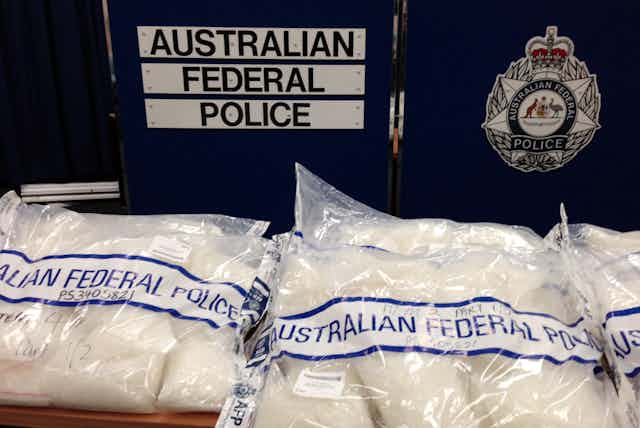The Australian Crime Commission (ACC) has identified crystal methamphetamine, or ice, as the highest risk of all illicit drugs available in Australia. But will the government’s response to the issues set out in the National Ice Taskforce’s final report be effective in tackling the problem?
Australia’s ice problem
The report presents a comprehensive picture of ice in Australia. It draws on mounting evidence in an attempt to justify a full-bodied response to the problem.
The report suggests there are more than 200,000 ice users in Australia – but it notes that this figure is likely conservative.
According to the National Drug Strategy Household Survey, levels of methamphetamine use have remained stable since 2010. However, new evidence presented to the taskforce from the National Drug and Alcohol Research Centre (NDARC) suggests the use of ice by regular and dependent users has increased each year from 2009 through to 2014.
The taskforce observed higher levels of use in young people, the unemployed and LGBTI people. The taskforce suggests the integral role of social networks in supply and distribution are leading to ice’s “normalisation” within user groups. It has also been flagged as an emergent issue for Indigenous, regional and remote communities, and possibly inmate populations.
Other notable trend changes include a 22% decrease in use of methamphetamine’s powder forms since 2010. This was associated with a doubling in ice use to more than 50% of the 2.1% reporting use in the general population in 2013.
A Melbourne study corroborated these findings. It indicated that users reported a transition from powder to crystal forms. Weekly or more frequent ice use increased by 10%. Consumption frequency of powder forms declined.
NDARC reported that injecting behaviours have also become more prevalent nationally. Ice use among injecting drug users has increased by 52% in the past decade. The most common routes of administration are smoking and injecting – both of which are closely linked with developing dependence and other health risks.
Dependent ice users have complex physical and mental health needs, which the health sector is meeting at the coalface. The Australian Medical Association has called for resources to better support and equip health workers who are experiencing the increased severity of ice-related health conditions. The need to improve supports for frontline services is a recurrent theme in the taskforce’s report.
Ice has proven itself to be a challenging opponent in the face of amplified law enforcement efforts. Attempts to disrupt its supply have helped to reveal the nature of the problem. ACC data shows that, excluding MDMA, the number of amphetamine-type substances (ATS) detected at the border reached record heights in 2013-14, as did national ATS seizures and arrests in the same period.
Within this data, ice emerged as a standout. The number and weight of detections grew at a considerably greater rate than other ATS detections.
In tackling this problem, the prevailing message from across sectors has been that the government must learn from experience and avoid adopting a blinkered law enforcement approach. Rather, the response must be measured, multifaceted and generate substantive policy through a fair allocation of resources.
What the taskforce recommended
The taskforce is just one of many recent Australian governmental responses to ice. Others include a Victorian parliamentary inquiry in 2014 and a current federal joint parliamentary committee inquiry.
These other inquiries have primarily focused on law enforcement efforts. The taskforce, however, focused on opportunities to improve education, health, law enforcement and other policies across all levels of government.
In its final report, the taskforce identifies five areas of priority, and it makes 38 recommendations to address these. The five areas are:
prioritising support for families, workers and communities to better respond to people affected by ice;
increasing efforts to reduce demand for ice through prevention activities;
recognising that ice users need treatment and support services that cater to their needs;
disrupting drug trafficking and supply networks through a more co-ordinated and targeted approach; and
a more rigorous approach to research and regular reporting is needed to strengthen Australia’s response and keep it on track.
The report echoes the comments of senior police officers from Queensland, Tasmania and the Australian Federal Police that Australia cannot just arrest its way out of the war on ice.
The taskforce notes that the ice market has been extraordinarily resilient due to manufacturing processes, ease of transport, the dichotomy of local crime syndicates as producers and the influence of transnational crime groups as importers.
Additionally, the taskforce recognises the lack of mature collaboration and co-ordination arrangements between Commonwealth, state and territory law enforcement agencies. Its report observes that challenges remain in ensuring a unified response and the timely exchange of intelligence in relation to ice.
Will it work?
The taskforce acknowledges that this war will not be won overnight and will not be won by law enforcement alone. It recognises that practical programs and supportive funding need to be put in place to address those already using ice and those susceptible to using it.
Having identified where the stakeholders are failing, the challenge will be to get them to recognise these failings and move forward in a spirit of co-operation.
The report argues that the Australian government needs to:
… introduce a simplified governance model to support greater cohesion and coordination of law enforcement, health, education and other responses to drug misuse in Australia, with a direct line of authority to relevant ministers responsible for contributing to a national approach.
The taskforce has presented a framework for tackling the multiple issues ice presents for Australian society. It is now in government’s hands to take this framework and implement real initiatives to have any chance of success.
Further reading: Ice report marks a welcome shift in thinking towards prevention and treatment

